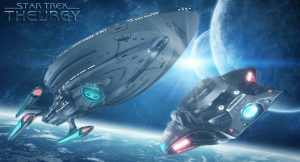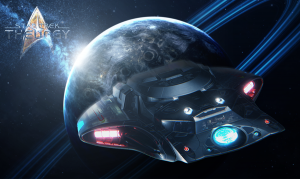USS Allegiant NX-80978: Difference between revisions
From Star Trek: Theurgy Wiki
Auctor Lucan (talk | contribs) No edit summary |
m (→Project Manta) |
||
| Line 88: | Line 88: | ||
== Project Manta == | == Project Manta == | ||
Manta was the culmination in a long line of mission-specialized auxiliary craft starting with earlier development of the Peregrine-class Federation Attack Fighter. The successful deployment of this ship for patrols near the Cardassian DMZ led to the development of a hybrid Runabout-fighter geared towards atmospheric flight and combat but also equipped with specialized sensor packages allowing for detailed planetary scans. This project led to the aeroshuttle-design, though it never gained much widespread use. | Manta was the culmination in a long line of mission-specialized auxiliary craft starting with earlier development of the Peregrine-class [[United Federation of Planets|Federation]] Attack Fighter. The successful deployment of this ship for patrols near the Cardassian DMZ led to the development of a hybrid Runabout-fighter geared towards atmospheric flight and combat but also equipped with specialized sensor packages allowing for detailed planetary scans. This project led to the aeroshuttle-design, though it never gained much widespread use. | ||
Its advanced sensor package and atmospheric capabilities were further fine-tuned into the development of the Talon-class scout ship, which had gained much more widespread use within the Federation as a deep-space reconnaissance craft and as a medium sized military transport. | Its advanced sensor package and atmospheric capabilities were further fine-tuned into the development of the Talon-class scout ship, which had gained much more widespread use within the [[United Federation of Planets|Federation]] as a deep-space reconnaissance craft and as a medium sized military transport. | ||
Given the Talon's advanced sensors and its capabilities to be further amplified, small sleets of these crafts could be deployed along the [[United Federation of Planets|Federation]]'s various neutral zones to aide in the detection of cloaked ships. | Given the Talon's advanced sensors and its capabilities to be further amplified, small sleets of these crafts could be deployed along the [[United Federation of Planets|Federation]]'s various neutral zones to aide in the detection of cloaked ships. | ||
[[File:U s s allegiant manta class advanced scout by auctor lucan-d9zivg3.png |left|thumbnail|USS Allegiant (commonly ref. as "the Yacht")]]Another notable accomplishment of the Talon-class was how its size and flight-profile was used in the development for the first wave of experimental fighters in the Valkyrie-project. With the commissioning of a Mk III iteration of the Valkyrie Attack Fighter, the Talon-class scout ship was becoming outclassed and it was becoming apparent that in an arms-race where a single fighter could potentially destroy the scout, improvements were required to be made in order to keep the aeroshuttle-series a viable tactical choice. | [[File:U s s allegiant manta class advanced scout by auctor lucan-d9zivg3.png |left|thumbnail|USS Allegiant (commonly ref. as "the Yacht")]]Another notable accomplishment of the Talon-class was how its size and flight-profile was used in the development for the first wave of experimental fighters in the [[AC-307 Mk II Valkyrie|Valkyrie]]-project. With the commissioning of a [[AC-409 Mk III Valkyrie|Mk III]] iteration of the Valkyrie Attack Fighter, the Talon-class scout ship was becoming outclassed and it was becoming apparent that in an arms-race where a single fighter could potentially destroy the scout, improvements were required to be made in order to keep the aeroshuttle-series a viable tactical choice. | ||
It was with this in mind that development began on the first prototype of the new Exploration Scout. The exploration scout would be viable for much longer mission lengths and would house a larger crew while still retaining the "aerowing" design that had made the series excel in atmospheric situations. It was decided that in lieu of a standard Talon-class scout being embedded into the ''Theurgy''’s hull as a Captain's Yacht, the ''Theurgy'' would have its hull modified to have the Manta instead. | It was with this in mind that development began on the first prototype of the new Exploration Scout. The exploration scout would be viable for much longer mission lengths and would house a larger crew while still retaining the "aerowing" design that had made the series excel in atmospheric situations. It was decided that in lieu of a standard Talon-class scout being embedded into the ''Theurgy''’s hull as a Captain's Yacht, the ''Theurgy'' would have its hull modified to have the Manta instead. | ||
Revision as of 21:00, 7 July 2016
Designated as a Manta-class Advanced Scout, the USS Allegiant (commonly ref. as "the Yacht"), like many of the other things stationed on the USS Theurgy, is an experimental prototype. When it was decided that the Theurgy would serve as an experimental testbed for both a fighter squadron of the new Mark III Valkyries and for a new system of computer interface (the Ship A.I.) it was decided that for a Captain's Yacht they would integrate the prototype for the newest in the aeroshuttle series of scouting vessels into the hull of the saucer vector. It was an augmented version of the Talon-class scout, only refereed to as Project Manta by the Advanced Starship Design Bureau.
Scoutship Demonstration
Project Manta
Manta was the culmination in a long line of mission-specialized auxiliary craft starting with earlier development of the Peregrine-class Federation Attack Fighter. The successful deployment of this ship for patrols near the Cardassian DMZ led to the development of a hybrid Runabout-fighter geared towards atmospheric flight and combat but also equipped with specialized sensor packages allowing for detailed planetary scans. This project led to the aeroshuttle-design, though it never gained much widespread use.
Its advanced sensor package and atmospheric capabilities were further fine-tuned into the development of the Talon-class scout ship, which had gained much more widespread use within the Federation as a deep-space reconnaissance craft and as a medium sized military transport.
Given the Talon's advanced sensors and its capabilities to be further amplified, small sleets of these crafts could be deployed along the Federation's various neutral zones to aide in the detection of cloaked ships.
Another notable accomplishment of the Talon-class was how its size and flight-profile was used in the development for the first wave of experimental fighters in the Valkyrie-project. With the commissioning of a Mk III iteration of the Valkyrie Attack Fighter, the Talon-class scout ship was becoming outclassed and it was becoming apparent that in an arms-race where a single fighter could potentially destroy the scout, improvements were required to be made in order to keep the aeroshuttle-series a viable tactical choice.
It was with this in mind that development began on the first prototype of the new Exploration Scout. The exploration scout would be viable for much longer mission lengths and would house a larger crew while still retaining the "aerowing" design that had made the series excel in atmospheric situations. It was decided that in lieu of a standard Talon-class scout being embedded into the Theurgy’s hull as a Captain's Yacht, the Theurgy would have its hull modified to have the Manta instead.
Just like it's registry, it was also given an official name besides 'the Yacht', and that was the Allegiant.
Tetryon Pulse Sensor Probe
Part of the advanced Manta Project, this probe uses tetryon pulse technology. The primary use of this probe is to fire into an area where it is suspected that cloaked ships may wish to enter into Federation space.
Once launched the probe begins to emit tetryon pulses which reflect off most cloaking systems (various types of phase cloaks are exceptions to this method of detection). The Allegiant is outfitted with a special sensor array designed to be able to detect even the most minute of these tetryon pulse reflections and therefore is well suited to carry a tetryon pulse probe into an area. Once launched, the craft can then monitor the area for potential cloaked vessels.
Interior Layout
The cargo bays can be easily converted into passenger quarters by moving bunk cots as beds. Each warp nacelle is powered by a separate warp core, both of which feed into the opposite side's "nacelle" as well. In the event that one core is ejected, the ship should, theoretically, be able to fly at low warp velocities.
The cockpit is holds one central seat with two control stations behind it, creating a copilot and tactical desk as well as a Captain's chair against the back wall. During missions, the Co-pilot may act in both a Communications and Ops capacity, in some cases in a Mission-Ops type role as well. Basically, if its a duty other than sensors, flying, firing weapons, or operating shields, then it is probably going to be handled via the Co-pilot's station. As a general rule - like the helm of a starship - the pilot's job is to fly. If there is no one at Tactical, then the pilot flies, controls weapons, and controls shields, similar to the role of a Tactical CONN officer when piloting a fighter.
Adjacent to the cockpit is the Sensor and Sciences room. Sensor room has a small porthole to the front. Captain's observation room has a large transparent aluminium window similar to observation lounge windows. If the captain is not aboard the yacht, the Captain's Quarters and similar rooms are locked and are not to be entered. If the captain wishes for the ranking officer of the ship to be given the use of the Captain's luxuries, then it is the Captain's right to grant that single officer access for duration of the mission.




